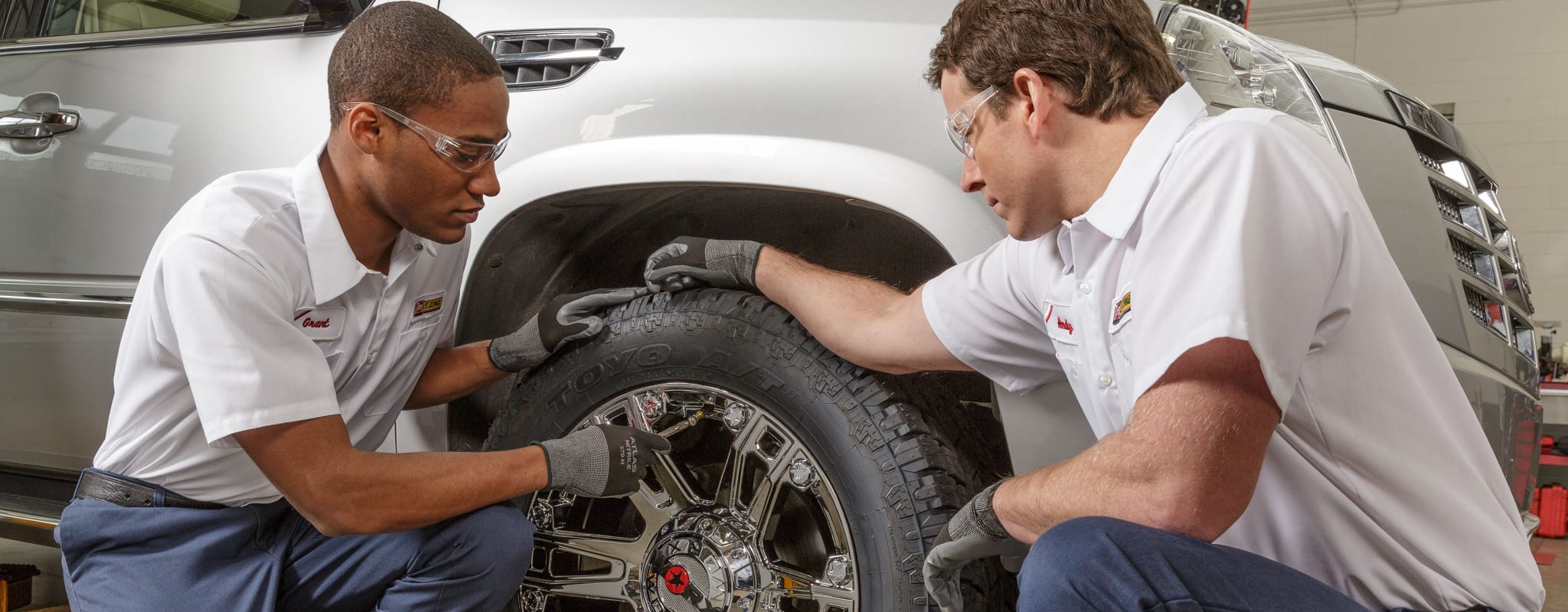Tire Shop Near Me: Discover Morris IL's Top Deals
Tire Shop Near Me: Discover Morris IL's Top Deals
Blog Article
Expert Guide to Tire Repair Work: Everything You Required to Know
Browsing the world of tire repair work can be an overwhelming job for several vehicle proprietors. From recognizing the typical root causes of tire damage to understanding the elaborate steps entailed in covering up a leak, there is a wealth of understanding to grasp. In this thorough overview, we will unravel the intricacies of tire fixing, clarifying the different kinds of fixing kits available and offering valuable understandings into when it could be time to bid farewell to a worn-out tire. Remain tuned as we dig deeper right into the nuances of tire upkeep, equipping you with the important know-how to ensure your tires stand the test of time.
Typical Reasons For Tire Damage
What are the common causes that lead to tire damages, influencing lorry performance and safety? Tire damage can take place due to different aspects, with one of the key factors being inappropriate rising cost of living pressure.

One more usual root cause of tire damages is insufficient walk depth. Worn-out footsteps can compromise grip on the road, particularly in damp or unsafe problems, raising the risk of accidents. Additionally, driving over pockets, particles, or sharp things can pierce or create cuts in the tire, weakening its structure and possibly creating a flat.
Furthermore, improper wheel alignment and out of balance tires can additionally add to tire damages. Misaligned wheels can result in unequal wear patterns, while unbalanced tires can cause vibrations, influencing both the lorry's handling and the tire's long life. Routine upkeep checks and timely repairs can help minimize these usual reasons for tire damage, ensuring optimum lorry performance and safety.
Sorts Of Tire Repair Kits
To attend to the after-effects of usual sources of tire damages talked about earlier, it is necessary to recognize the different kinds of tire fixing kits available for lorry proprietors. There are mainly 3 sorts of tire repair sets generally used: plug kits, patch packages, and mix fixing sets.
Plug kits are a fast and easy option for fixing small slits triggered by nails or screws. They include a T-handle tool and rubber plugs that can be put into the leak to seal the opening successfully. Spot sets, on the various other hand, are preferable for bigger punctures or cuts in the tire. These sets consist of a patch and glue product that is applied to the inner cellular lining of the tire to cover the damaged area firmly.
Combination repair service packages provide the benefit of including both plug and spot components, offering a thorough solution for a range of tire damages scenarios. It is essential for lorry proprietors to familiarize themselves with these different types of tire repair work packages to be prepared for any unforeseen tire concerns when driving.

Actions to Fix a Tire Puncture
Repairing a tire puncture needs an organized approach and the right tools to guarantee a risk-free and reliable service. When confronted with a punctured tire, the primary step is to securely draw over to a flat, steady surface area far from website traffic. Involve the hand brake and place wheel chocks behind the tires to stop any unintentional rolling. Next, eliminate the punctured tire complying with the car maker's standards. When the tire is eliminated, check the punctured area to locate the foreign object causing the leak. Use a reaming device to tidy and rough up the puncture opening for far better attachment. Apply rubber concrete to the area and insert a plug using a plug insertion tool. Cut any kind of excess plug product flush with the tire walk. Lastly, reinflate the tire to the suggested stress and reinstall it onto the car. Conduct a detailed leakage check utilizing soapy water to make sure the puncture is successfully secured before returning to regular driving.
When to Replace a Tire
Identifying the suitable time More hints for tire see post replacement requires a thorough assessment of various essential elements associated to tire wear and security. As tires use down, the deepness of the step declines, influencing the tire's hold on the roadway. Also if the walk depth shows up adequate, tires older than 6 years should be very carefully examined, as the rubber can wear away over time, making the tire more prone to failure.

Tire Maintenance Tips for Long Life
After examining key variables connected to tire wear and security, implementing appropriate tire upkeep techniques is vital for making the most of the durability of your tires. Regularly inspecting tire pressure is important, as underinflated tires can lead to enhanced wear and lowered gas effectiveness.
Turning your tires at regular periods, commonly every 5,000 to 7,000 miles, advertises even step wear across all tires. This method expands the life of your hop over to here tires and makes sure ideal performance. Checking tires for indications of damage, such as cuts, bulges, or slits, is also important for preserving tire longevity. Driving practices play a substantial role in tire wear. Avoiding sudden quits, doglegs, and extreme speeding can help maintain your tires and enhance security on the roadway. By following these tire maintenance suggestions, you can maximize the life expectancy of your tires and make certain a smooth driving experience (morris tire).
Conclusion
To conclude, recognizing common root causes of tire damage, making use of the proper tire fixing packages, adhering to correct actions to fix a tire slit, recognizing when to replace a tire, and carrying out tire maintenance tips are vital for making best use of the long life of your tires. By remaining notified and aggressive in addressing tire problems, you can make sure security when traveling and prolong the lifespan of your tires.
Report this page